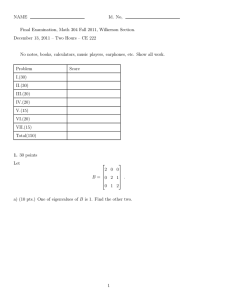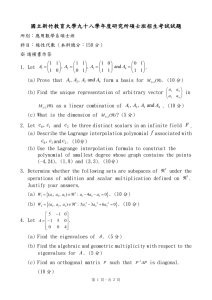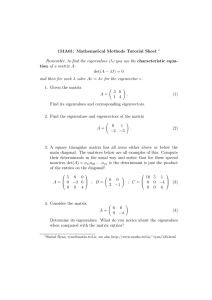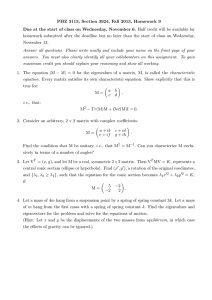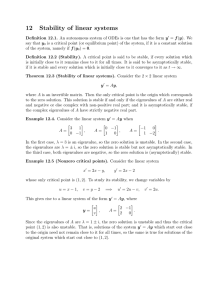EXAM I – MATH 443, SPRING 2009 Wed, Mar 4, 2009
advertisement
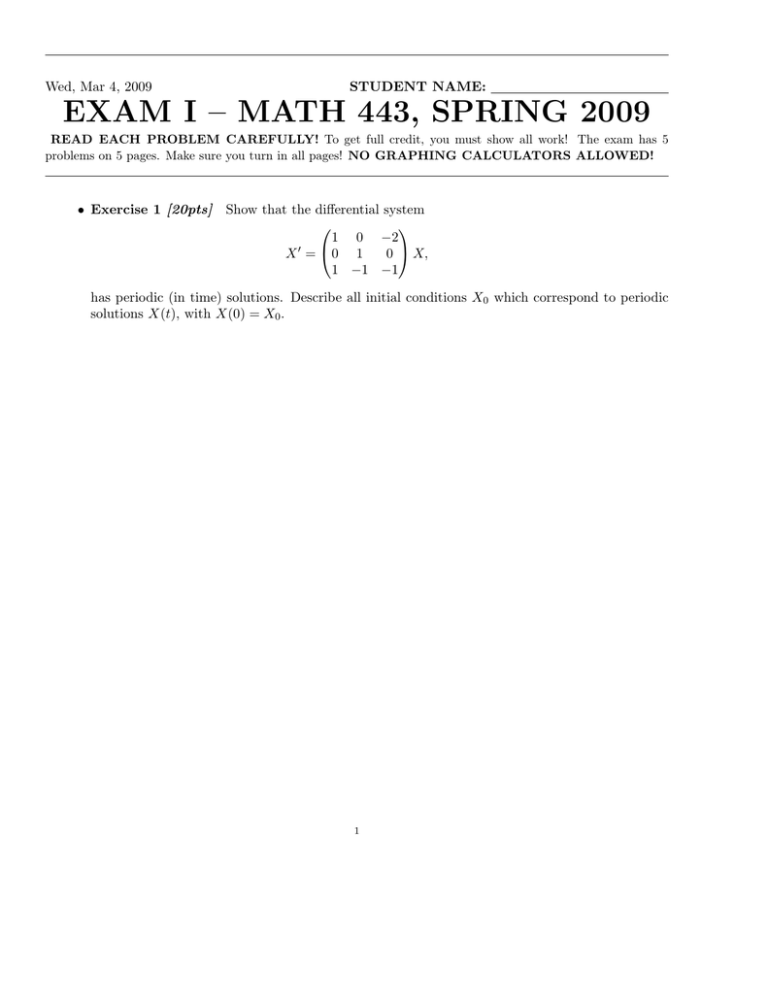
Wed, Mar 4, 2009 STUDENT NAME: EXAM I – MATH 443, SPRING 2009 READ EACH PROBLEM CAREFULLY! To get full credit, you must show all work! The exam has 5 problems on 5 pages. Make sure you turn in all pages! NO GRAPHING CALCULATORS ALLOWED! • Exercise 1 [20pts] Show that the differential system 1 0 −2 0 X, X 0 = 0 1 1 −1 −1 has periodic (in time) solutions. Describe all initial conditions X0 which correspond to periodic solutions X(t), with X(0) = X0 . 1 • Exercise 2 [20pts] Given the (nonlinear) differential equation x0 = x2 − 2ax + b (a) Determine the equilibria (in terms of the parameters a and b). (b) Sketch the phase lines and direction fields for the values (a, b) = (0, 4), (2, 4) and (4, 4). (c) Identify the regions in the parameter plane (a, b) where the system has distinct behavior (that is, the systems corresponding to different regions are not conjugate). Explain your conclusion. • Exercise 3 [20pts] (a) Determine whether each of the following statements is TRUE or FALSE, ( giving a brief explanation if true and or a counterexample if false Two 2 × 2 linear differential systems are conjugate if and only if they have (counting multiplicity): (i) the same number of eigenvalues with negative real part ; TRUE FALSE (ii) the same number of eigenvalues with positive real part ; TRUE FALSE (iii) the same number of pure imaginary eigenvalues. TRUE FALSE (b) Let A be a 3 × 3 matrix with eigenvalues −1 and 2 ± i and B a 3 × 3 matrix with eigenvalues −3 and 1 ± 2i. Assume both are in canonical form. Sketch a typical solution for each of the systems X 0 = AX and Y 0 = BY . Determine whether these systems are conjugate or not. (c) Let A be a 4 × 4 matrix with eigenvalues −1, 2 ± i and B a 4 × 4 matrix with eigenvalues −3, 1 ± 2i. List all possible combinations of canonical forms for A and B. Does the same conclusion, as in (b), hold? [Hint: Using the homeomorphisms h̃ : R2 → R2 which exist between conjugate 2 × 2 systems, such as in part (a), write down a homeomorphism h : R4 → R4 which acts as a conjugacy between the two 4 × 4 systems.] • Exercise 4 [20pts] Find the general (real-valued) solution of the system X 0 = AX, 2 0 where A = 0 0 1 0 2 0 0 3 0 −1 0 0 1 3 • Exercise 5 [20pts] 0 1 0 (a) Show that the matrix B = 0 0 1 is such that B k = 0 for some k > 0. 0 0 0 (b) Compute exp(tB). λ 1 0 λ 0 0 0 1 0 (c) For λ 6= 0, let A = 0 λ 1 = 0 λ 0 + 0 0 1 = λI3 + B. 0 0 λ 0 0 λ 0 0 0 Show that 1 t t2 /2 t exp(tA) = etλ 0 1 0 0 1 (d) Write down exp(tC) (no need to show computations, just briefly explain your answer) for 2 1 0 0 0 0 2 1 0 0 C= 0 0 2 0 0 0 0 0 2 1 0 0 0 0 2



